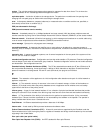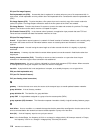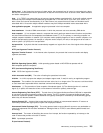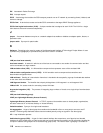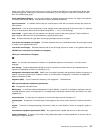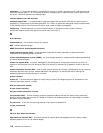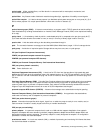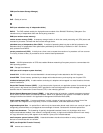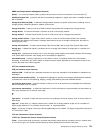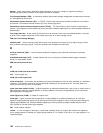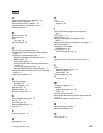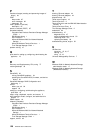SNMP (see Simple Network Management Protocol).
splitter. In a local area network (LAN), a passive device used at a node to connect two or more branches (T).
standby hot-spare disk. A physical disk that is automatically mapped to a logical drive when no suitable hot-spare
disk is available.
Storage Area Network (SAN). A dedicated storage network tailored to a specific environment, combining servers,
storage products, networking products, software, and services.
storage controller. A device (such as a RAID Controller) that creates and manages other storage devices.
storage device. A LUN that terminates a collection of ports on the storage network.
storage network. Provides shared access to a set of LUNs across one to n storage client networks.
storage network device. A type of hub, switch, director or router on the Fibre Channel fabric that is directly
connected to the storage client network. A storage network device is part of the fabric infrastructure, but does not
directly provide LUNs.
storage client network. A classic interconnected Fibre Channel fabric with a single Fibre Channel fabric name.
storage port. A Model 200 engine’s connection point to a storage client network. A storage port is a member of a
single fabric.
storage unit. Hardware that contains one or more drive bays, power supplies, and network interface. Some storage
units contain RAID controllers; their storage unit is accessed by the appliance.
store-and-forward. A mode of operation for a LAN switch in which it completely checks every frame before
forwarding, so customers can use the switch to isolate erroneous frames generated on one segment so they do not
traverse the switch onto another segment.
STP (see shielded twisted pair).
SVN (see switched virtual network).
switched LAN. A LAN that has a dedicated connection for each user whereby the full bandwidth is available to the
workstation.
switched virtual networks (SVN). A comprehensive approach for building and managing switched-based networks.
It combines the virtues of LAN switching, bridging, routing, ATM switching and other switched services.
synchronous data transfer. A physical transfer of data to or from a device that has a predictable time relationship
with the execution of an I/O request.
synchronous transmission. A method of transmission in which characters are synchronized by the transmission of
initial sync characters and a common clock signal.
T
tape device. A collection of tape units that come from one model type and serial number (such as all the LUNs of a
tape library).
tape unit. A tape drive or a robotics controller that is visible over a storage network. A tape unit is a member of a
single storage network (of 1 to n fabrics), but can have 1 to n equivalent paths.
target. A collection of logical units that are directly addressable on the network. The target corresponds to the server
in a client-server model.
TCP (see Transmission Control Protocol).
TCP/IP (see Transmission Control Protocol/Internet Protocol).
Telnet. In the Internet suite of protocols, a protocol that provides remote terminal connection service. It allows users
of one host to log on to a remote host and interact as directly attached terminal users of that host.
IBM Glossary of Storage Networking Terms 121



